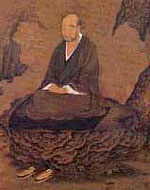Koso Wasan 52
Because one does not realise shinjin that is decisive,
It is not genuine; this T'an-luan teaches.
Whether practice is fully in accord with reality
Is determined solely by shinjin.
Reality

In a marginal note, Shinran Shonin draws attention to the phrase 'practice is fully in accord with reality', and he identifies this as 'to entrust oneself to Amida Buddha in accord with the teaching'.
This explanation is a paraphrase of a passage in the Commentary on the Treatise (of Bodhisattva Vasubandhu) by T'an luan, as follows:
... if you ask why ignorance still remains and your aspirations are not fulfilled even though you say the Name and are mindful of Amida, it is because you do not practice in accord with reality, because you are not in correspondence with the significance of the Name. Why is your practice not in accord with reality and not in correspondence with the significance of the Name? Because you do not know that the Tathagata is the body of true reality and, further, the body for the sake of beings.1
This is the teaching: that the Tathagata is the body of true reality and for the sake of beings. Shinjin will only endure when we know that Amida Tathagata is the dharma body as compassionate means (hoben hosshin), the Tathagata of fulfilled body.
The dharma body as compassionate means has the form of inconceivable light: wisdom and compassion.
From this treasure ocean of oneness form was manifested, taking the name of Bodhisattva Dharmakara, who, through establishing the unhindered Vow as the cause, became Amida Buddha. For this reason Amida is the 'Tathagata of fulfilled body.' Amida has been called 'Buddha of unhindered light filling the ten quarters.' This Tathagata is also known as Namu-fukashigiko-butsu (Namo Amida Butsu of Inconceivable Light) and is the 'dharma-body as compassionate means.' 'Compassionate means' refers to manifesting form, revealing a name, and making itself known to sentient beings. It refers to Amida Buddha. This Tathagata is light. Light is none other than wisdom; wisdom is the form of light. Wisdom is, in addition, formless; hence this Tathagata is the Buddha of inconceivable light. This Tathagata fills the countless worlds in the ten quarters, and so is called 'Buddha of boundless light.' Further, Bodhisattva Vasubandhu has given the name, 'Tathagata of unhindered light filling the ten quarters.'2
Amida Buddha is a living entity. Beings experience this Buddha as an active reality, with whom they interact, as they listen the the call of the Name, and who becomes at one with us in Namo Amida Butsu at the awakening of shinjin. To conceive of Amida Buddha in any other way is not to 'entrust oneself in accord with the teaching.' In such a case, shinjin is not genuine.
There is no need to try to rationalise Amida Buddha or even to make self-conscious effort to 'believe'. Such intellectual speculation can carry us a certain distance but, in the end, true insight will only come to us directly from Amida Buddha. Thereafter, nothing can shake us; we are protected in the Buddha's inconceivable light. We only need to permit ourselves to trust the Name and say it in joyful celebration of the Buddha's embrace.
Dharmakara Bodhisattva, who became Amida Buddha as compassionate means is integral to Amida Buddha, and not a mere representation of something else. Just as I contain the lived experiences of my childhood within my adult reality, so Amida Buddha has descended from 'the treasure ocean of oneness' manifested, at first, in the life of Dharamkara.
The character of Dharmakara is given in the Larger Sutra.
No thought of greed, anger, or harmfulness arose in his mind; he cherished no impulse of greed, anger, or harmfulness. He did not cling to objects of perception - color, sound, smell, taste. Abounding in perseverance, he gave no thought to the suffering to be endured. He was content with few desires, and without greed, anger, or folly. Always tranquil in a state of samadhi, he possessed wisdom that knew no impediment. He was free of all thoughts of falsity or deception. Gentle in countenance and loving in speech, he perceived people's thoughts and was attentive to them. He was full of courage and vigor, and being resolute in his acts, knew no fatigue. Seeking solely that which was pure and undefiled, he brought benefit to all beings. He revered the three treasures and served his teachers and elders. He fulfilled all the various kinds of practices, embellishing himself with great adornments, and brought all sentient beings to the attainment of virtues.3
Shinjin will endure when this living reality finds its home within our hearts. It is the 'virtue' of Amida Buddha; the detail of Amida's light, wisdom and compassion. It is the virtue beings receive as shinjin when they accept the call of the Primal Vow in Namo Amida Butsu.
1: CWS, p. 82
2: CWS, p. 486.
3: CWS, p. 95.